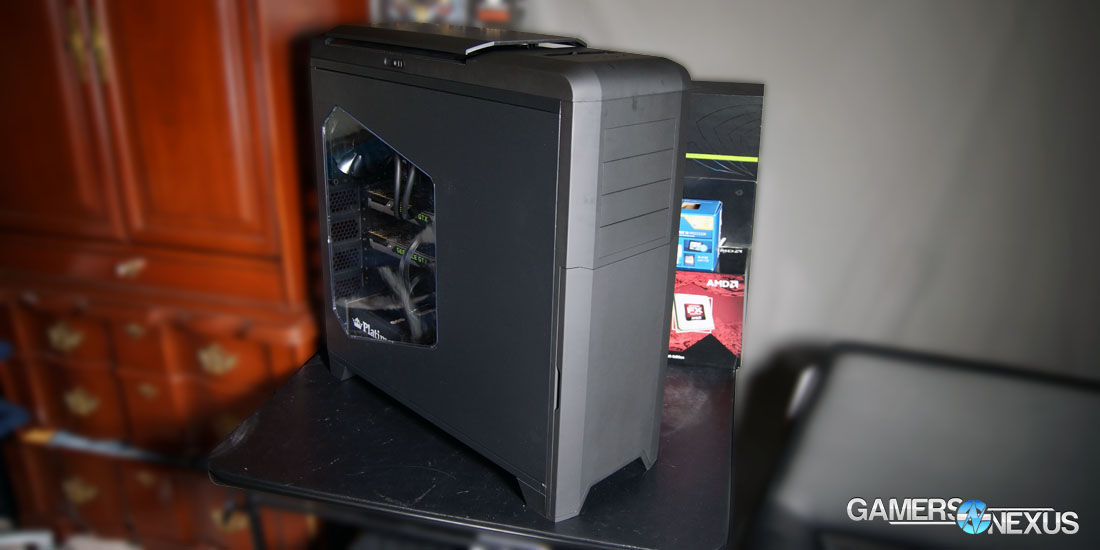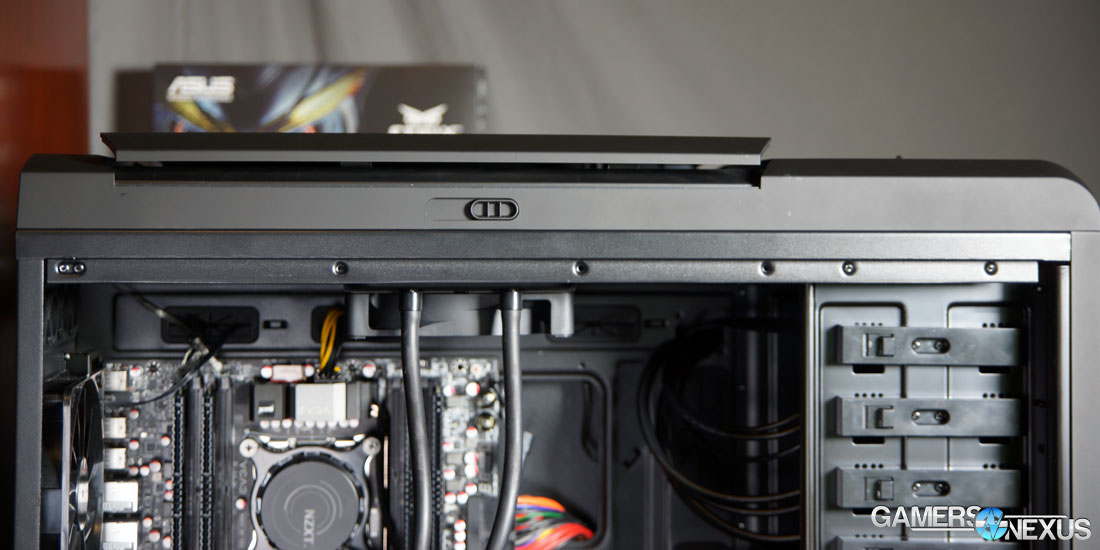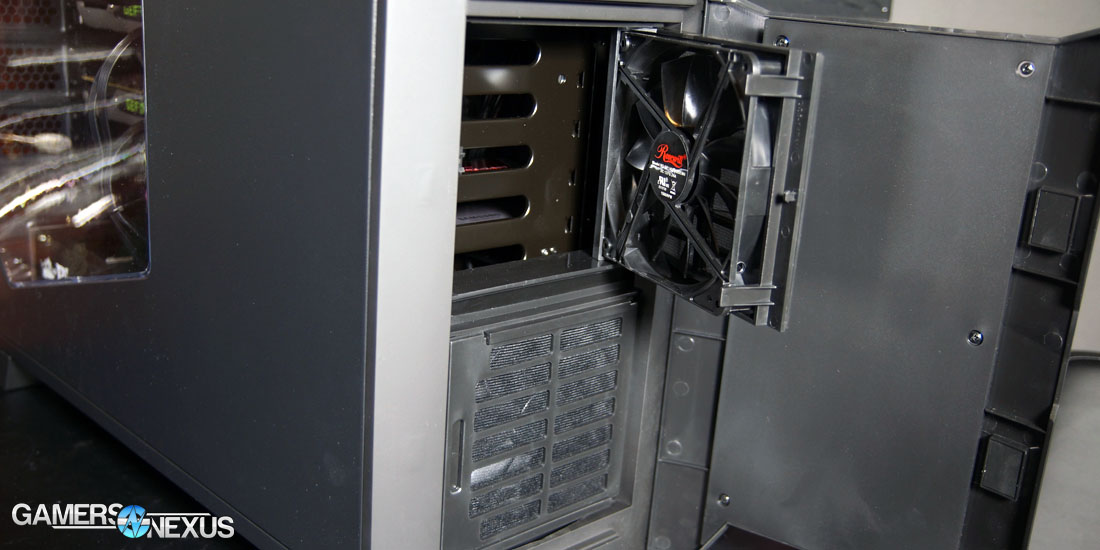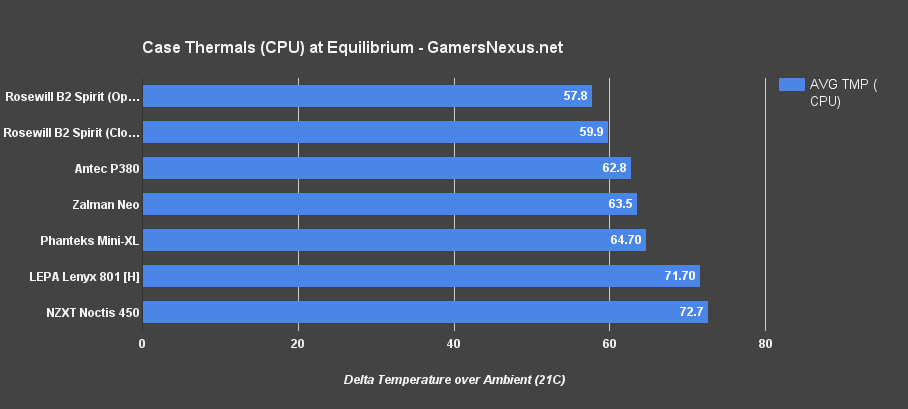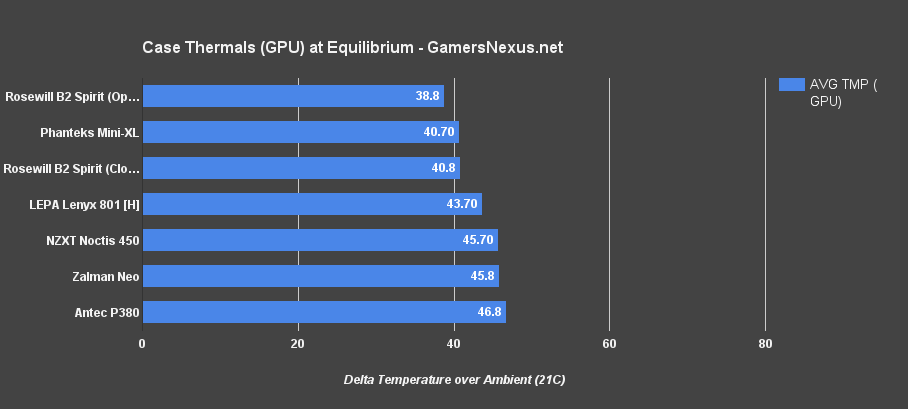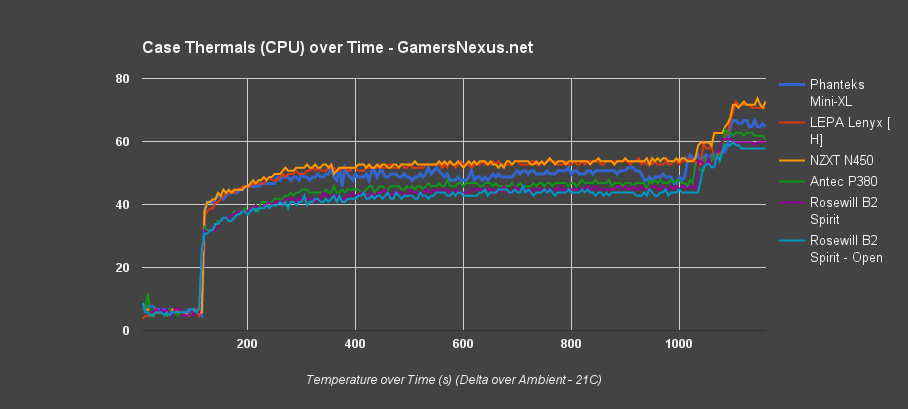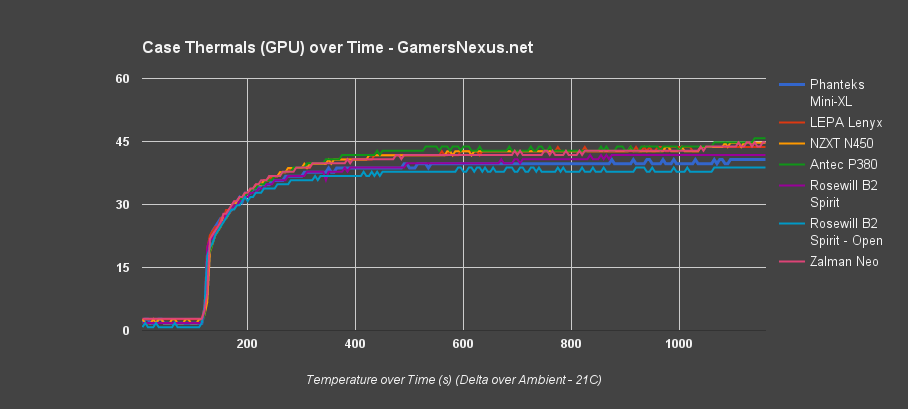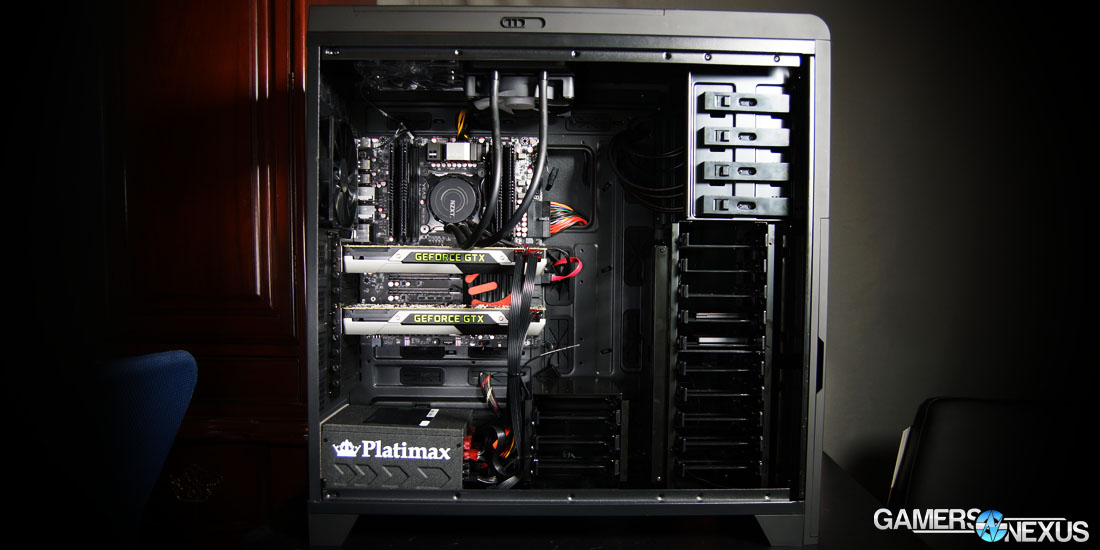Active users of the site will notice that we've gotten back into case reviews recently and, thanks to some new methods, we've gone a lot deeper with methodology than previously. The bench now includes thermal-over-time charts – which add great value to design analysis – and we've spoken with a number of experts on small design features to spot. Until now, all the 2015 cases we've looked at have been mid-tower or smaller. This B2 Spirit ($180) enclosure is a giant in comparison; in fact, it can nearly fit an entire NZXT S340 within it.
The Rosewill B2 Spirit full-tower case is targeted at gaming PC builds, but can readily fit server-class HPTX motherboards. It's got some unique design features, like pop-out fans and an elevated top-panel plate, but also has some unique oversights. This Rosewill B2 Spirit review tests case build quality, temperatures, and competitive alternatives.
Rosewill B2 Spirit Case Specs
| Motherboard Size | Micro-ATX ATX E-ATX XL-ATX HPTX |
| Material | Steel Rubber coating (top, front) |
| Side Panel Window | Yes |
| Expansion | 4x 5.25" 13x 3.5/2.5" 10x Expansion Slots |
| Front I/O | 4x USB3.0 2x USB2.0 2x 3.5mm |
| Cooling (Air) | Pre-Installed 2x 140mm front 2x 140mm top (blue LED) 1x 140mm rear Optional 1x 140mm top or 2x 200mm top 1x 140mm bottom |
| Radiator Support | 280mm top or front |
| Clearances | CPU Cooler: 200mm VGA: 400mm |
| Dimensions | 23.83" x 9.84" x 24.02" 39.24 lbs. |
| Price at Review | $180, with ~$40 of discounts |
Rosewill's self-dubbed flagship enclosure is outfitted for ATX through HPTX form factor motherboards. The enclosure includes 2x 140mm front fans (no LED) on hinged doors, 2x 140mm top fans (blue LEDs), and 1x 140mm rear fan (no LED). Because the tremendous width of the case, there's a gap between expansion slot screw mounts and the side panel of the case; Rosewill has utilized this space for large grills, positioned above the video cards to provide a negative draw-point for the positive pressure intake.
The case can fit an additional 1x 140mm top fan, 2x 120mm bottom fans (but would require a small PSU and removal of a drive cage), or 1x 140mm bottom fan. The top fans could be swapped for 2x 200mm fans instead. A mid-case radiator mount is also present, just behind the drive cages.
Rosewill B2 Spirit Use Cases
The B2 Spirit uses a lot of aggressive phrases in its marketing: “Battle cruiser,” “incinerate your opponents,” “stealth.” It's clear that the vision for the case was one meant to match the B2 stealth bomber, though the case is anything but undetected at 24” deep and nearly 40 pounds in weight.
Tooling for the B2 Spirit allows installation of form factors scaling past ATX and into E-ATX, XL-ATX, and HPTX sizes. HPTX had a brief stint around the era of Skulltrail dual-CPU boards, and measures in at 13.6” x 15” (a fair bit larger than the ~12” x 12” ATX standard). The gargantuan size of the case means that it's easily capable of quad-SLI installation (with the right board) and that it's got a lot of room for storage devices.
In a sense, this almost makes the B2 Spirit feel like it's part of the “old guard” of cases – there's been a recent decrease in physical size, removal of drive bays (optical and 3.5”), and a shift toward minimalism. NZXT and Fractal are among the best examples of this shift. That doesn't invalidate the existence of more traditional, massive cases, though, and there's still a market for users who need HDD bays. The official render rig for this very website hosts five drives, and it will soon expand.
The B2 Spirit acts sort of like a server case. In that regard, the best use case scenarios would be those in which a system builder requires drive slots (of which there are 13), those who use large boards, and anyone who wants space and cooling for multi-GPU configurations.
That said, the B2 Spirit isn't for anyone – not nearly: The case is big enough that it is effectively relegated to floor positioning; it's immobile for LAN gamers; it's unnecessarily large for the vast majority of dual-drive, single-GPU gaming PC builds. In these instances, a $70 to $100 enclosure – the S340, the Fractal Define cases – would be better than the B2 Spirit.
Rosewill B2 Spirit Look, Feel, & Mechanics
Similar to the LEPA Lenyx we just reviewed, Rosewill's B2 Spirit uses a soft-grip rubberized coating for the case exterior. This material adds to the production cost of the product – rubber is a lot more expensive than paint – but it adds a more premium quality to the feel. The case is fingerprint- and reflection-resistant resultant of the soft-grip coating. It feels nice to the touch and blends into the background a little more readily, despite the large size. The side panels are steel and painted with a normal black paint, not the soft-grip rubber. This means the front, top, and side panels aren't perfectly matched in tone, reflectivity, and color depth – but they're close enough that it's basically irrelevant, unless you're sitting the thing under studio lights.
The panels are all flush against the frame and flush with one another, something we (depressingly) haven't found true for every case. A few unique, mechanical features provide a bit of showmanship to the case, but without going too heavy on the “1337 gamer” aesthetic that we often see. One of those features is the “convertible” top panel, which extrudes from the case with the press of a button. This provides more airflow (we tested with the panel closed and opened) at the cost of additional noise escaping from the case. It's a mechanical switch, something Rosewill's been fond of since the Thor V2 and the Throne cases.
The second mechanical feature is pretty simple, but a nice touch. The front 2x 140mm fans pop-out with an eject button, using a hinge to swing outward. The added function is easier access for cleaning (filters are installed) or fan replacement. These fans are covered by a discrete, flush, hinged front panel shield.
Rosewill B2 Spirit Cable Management & Installation
System installation is trivial. The Spirit doesn't necessarily do anything revolutionary to ease the build process, but it's big – and that means maneuverability. The case fits everything well and with almost too much extra room on the sides of our ATX EVGA X99 motherboard, but that's the biggest board we've got.
A few things struck me as oversights with the B2 Spirit.
For as many fans as it has (and is capable of), it's strange that Rosewill elected not to include a fan hub on the rear-side of the motherboard – especially since there's so much room back there. This would make installation easier and significantly cleaner on the cabling. There are cheaper cases that include this now-basic demand. It just seems like something no one thought to include.
Another strange oversight pertains to SSDs. The B2 Spirit can fit 13 drives. For these drives, it uses standard, plastic drive sleds with holes drilled for bottom-screw mount SSD installation. The sides of the sleds use the semi-ubiquitous steel bolts with rubber housing. If installing an SSD, it is impossible to line-up the holes to the drive without removing these steel bolts – an oversight, considering an SSD is just 2.5” and an HDD is 3.5”, so there should be room for both without modification of the existing mounting hardware. It doesn't impact function, but is an extra step that would have been mitigated by centering the SSD mount holes rather than right-aligning them. Just weird.
Cable length is also an issue, something that's true of nearly any massive, E-ATX ready case. This is more a matter of adequate PSU or cable selection than the case design, though we've seen some good solutions in the past. At a minimum, as NZXT did with the Phantom 820, it'd be good practice to include an 8-pin extender for the CPU power. It's nearly guaranteed that stock 8-pin cables won't reach that far, and the inclusion of an extension is just good user service.
Unfortunately, a 140mm radiator will not fit in the rear slot due to a curved bezel protruding from the expansion slot area (though it is also not advertised to fit), so we had to go with a top-mount. The front radiator position is far enough away from the fans (and covered by drives) that we'd recommend using a top-mount instead, as the direct fan contact will drastically improve dissipation performance of the radiator.
Continue to Page 2 for case testing methodology & thermal results!
Case Testing Methodology
We tested using our updated 2015 case test bench, detailed in the table below. Our thanks to supporting hardware vendors for supplying some of the test components.
Conducting thermal tests requires careful measurement of temperatures in the surrounding environment. We control for ambient – which is set to a constant 21C – and then produce charts using a Delta T(emperature) over Ambient value. This value subtracts 21C from the measured output, producing a delta report of thermals. AIDA64 is used for logging thermals of semiconductor components.
All case fans are manually configured to their maximum throughput using BIOS. This forces testing of case fan performance in addition to the case's air channeling and airstream design. This also ensures minimal variance when testing, as automatically controlled fan speeds can reduce reliability of benchmarking. The CPU fan is set to use a custom fan curve that was devised in-house after a series of testing; setting the CPU fan to its maximum speed can limit the disparity shown from case-to-case as the CPU cooler is extremely efficient, and will create a ceiling for thermal performance if bottlenecked.
We use two test benches for large cases and are in the process of adding SLI thermal testing.
| GN Case Test Bench 2015 | Name | Courtesy Of | Cost |
| Video Card | ASUS | $210 | |
| CPU | Intel i-4770K CPU | CyberPower | $340 |
| CPU Cooler | Be Quiet! Dark Rock 3 | Be Quiet! | $60 |
| Memory | HyperX Genesis 2x4GB | Kingston Tech. | $70 |
| Motherboard | ASRock Z97 Micro-ATX | GamersNexus | $100 |
| Power Supply | Be Quiet Dark Power Pro | Be Quiet! | $200 |
| SSD | Samsung 840 EVO | CyberPower | $140 |
| Case | This is what we're testing! | - | - |
The video card is configured to run at 55% fan speed at all times. Stock clocks are used. We employ an ASUS Strix GTX 960 (~$200) for the case test bench when using more budget-class cases. Additional SLI and high-end, high-heat cards are used when conducting testing on more expensive (higher-end) cases.
Prior to load testing, we collect idle temperature results for ten minutes to determine the unloaded cooling performance of a case's fans and air channels. Thermal benchmarking is conducted for twenty minutes, a period we've determined sufficient for achieving equilibrium. The over-time data is aggregated and will occasionally be compiled into charts, if interesting or relevant. The equilibrium performance is averaged to create the below charts.
Load testing is conducted using Prime95 LFFTs and Kombustor stress testing simultaneously.
| GN Case Test Bench 2015 | Name | Courtesy Of | Cost |
| Video Card | 2x GTX 980 Ti SLI | NVIDIA | $650 |
| CPU | Intel i7-5930K | iBUYPOWER | $585 |
| CPU Cooler | NZXT Kraken X41 | NZXT | $108 |
| Memory | HyperX Predator DDR4 | Kingston Tech. | $200 |
| Motherboard | EVGA X99 Classified | GamersNexus | $392 |
| Power Supply | Enermax Platimax 1350W | Enermax | $250 |
| SSD | HyperX Savage SSD | Kingston | $113 |
| Case | This is what we're testing! | - | - |
Rosewill B2 Spirit Thermals at Equilibrium
Tested at equilibrium – that is, once the temperature has ceased fluctuation – the B2 Spirit tops our 2015 charts for CPU and GPU thermals. The case was tested with the top flap both open and closed (indicated by the names in the charts). Open, we predictably see the B2 Spirit outranks its closed counterpart by about 2C for both CPU & GPU thermals. The difference is important, but negligible enough that we'd be comfortable leaving the top closed for the noise/dust advantage.
The B2 Spirit currently holds our Best of Bench recognition for its dominance over similarly-priced competitors, the Antec P380 included. The sheer size of the case is a great contributor to this factor; components are more spaced out and well-placed grills in the rear of the case assist in drafting positive pressure air across the GPU channel.
Rosewill B2 Spirit Thermals over Time
The B2 Spirit maintains its relatively low thermals throughout the entirety of our test, recovering from the end-test thermal spike faster than other cases. The N450 has a more stable thermal line than the B2 Spirit, so there's more fan speed fluctuation going on in the Spirit, but Rosewill's enclosure keeps a low temperature ceiling.
Conclusion: Competitive Price, but Gargantuan
Rosewill's B2 Spirit reminds us of the Throne and Thor V2, only it's bigger. The case has a limited target market for this reason. As a "gaming case," the size of the B2 Spirit is wholly unnecessary and the enclosure is outmatched by even an S340 for versatility and added functions, like a native fan hub. The B2 Spirit does win in cooling performance and drive support, though. Only builders who demand size for large form factor motherboards or complex drive configurations should truly consider the B2 Spirit, and if that's the case, its cooling is among the best we've looked at recently and its size is accommodating.
A number of small features are oddly absent from the B2 Spirit, like a fan hub for the rear side of the motherboard tray – it'd easily fit and would clean-up the five stock fans, but Rosewill opted out. We also wish that 140mm radiators would fit in the rear slot, but tooling oversights prevent this. Rosewill should consider including an extension cable for the 8-pin power header – not many PSUs will reach that far – and would do well to pre-tie some of the front panel headers, as NZXT does with its Phantom 820. The drive sled bolts must be removed to properly mount an SSD given the right-aligned SSD mount holes in the sled – another odd choice.
 Aside from these items, the case is big, fits as many video cards as your motherboard will allow, and can host 13 drives. The B2 Spirit is also extremely well-designed for dust, with its closed top-panel and massive dust filter on the under-side. The hinged front fans make for easy access and dust cleaning as the system ages. For dust management, we give the B2 Spirit a big plus. Cooling support is adequate, though frankly unnecessary given the tremendous performance of the stock configuration. The case is priced fiercely competitively at ~$140 after the current discount code is applied (RW15SEP) and $20 MIR is sent in. Before discounts, it's still not bad – $180, the same as the LEPA Lenyx we just reviewed. Still, users demanding an ATX case that's not quite as large as the B2 Spirit would do well to consider Corsair's 760T, one of our favorite cases right now. The overall presentation is a little cleaner and the tempered glass side panel allows fantastic visibility.
Aside from these items, the case is big, fits as many video cards as your motherboard will allow, and can host 13 drives. The B2 Spirit is also extremely well-designed for dust, with its closed top-panel and massive dust filter on the under-side. The hinged front fans make for easy access and dust cleaning as the system ages. For dust management, we give the B2 Spirit a big plus. Cooling support is adequate, though frankly unnecessary given the tremendous performance of the stock configuration. The case is priced fiercely competitively at ~$140 after the current discount code is applied (RW15SEP) and $20 MIR is sent in. Before discounts, it's still not bad – $180, the same as the LEPA Lenyx we just reviewed. Still, users demanding an ATX case that's not quite as large as the B2 Spirit would do well to consider Corsair's 760T, one of our favorite cases right now. The overall presentation is a little cleaner and the tempered glass side panel allows fantastic visibility.
As for users who truly demand large build area and want it less than $200, the B2 Spirit is a worthwhile consideration on the list of available cases and offers Best of Bench cooling potential.
- Steve “Lelldorianx” Burke.
